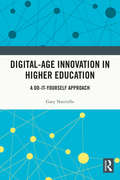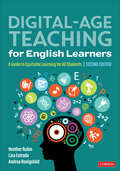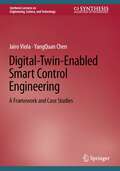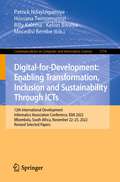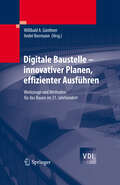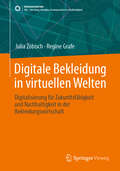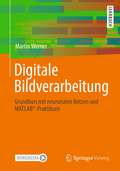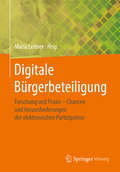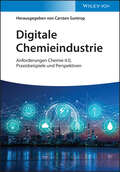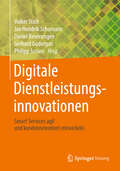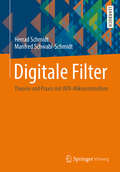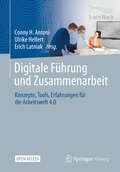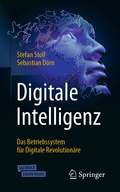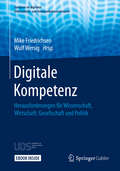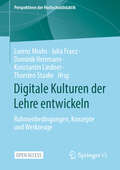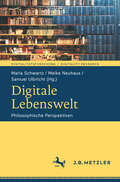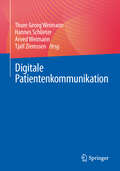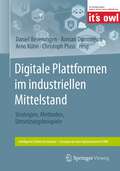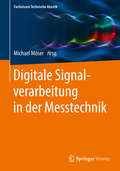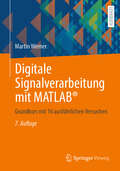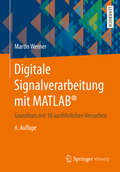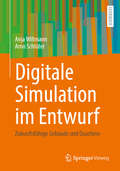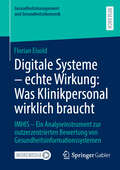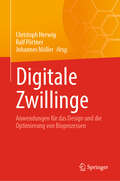- Table View
- List View
Digital-Age Innovation in Higher Education: A Do-It-Yourself Approach
by Gary NatrielloDigital-Age Innovation in Higher Education recounts the creation, development, and growth of an innovation unit within a major university. This single case study follows the development of the EdLab at the Gottesman Libraries of Teachers College, Columbia University, which was charged with developing new services and products at a time when digital technologies were markedly beginning to impact the sector. The major steps taken – recruiting staff in key skill areas, developing projects, collaborating across organizational lines, securing resources, delivering new services, and more – are covered in detail, illustrating the opportunities and challenges presented by innovation mandates in long-established organizations with stable operations and traditional academic values and practices.
Digital-Age Teaching for English Learners: A Guide to Equitable Learning for All Students
by Lisa M. Estrada Andrea Honigsfeld Heather RubinBridge the Digital Divide with Research-Informed Technology Models Since the first edition of this bestselling resource many schools are still striving to close the digital divide and bridge the opportunity gap for historically marginalized students, including English learners. And the need for technology-infused lessons specifically aligned for English learners is even more critically needed. Building from significant developments in education policy, research, and remote learning innovations, this newly revised edition offers unique ways to bridge the digital divide that disproportionally affects culturally and linguistically diverse learners. Designed to support equitable access to engaging and enriching digital-age education opportunities for English learners, this book includes Research-informed and evidence-based technology integration models and instructional strategies Sample lesson ideas, including learning targets for activating students’ prior knowledge while promoting engagement and collaboration Tips for fostering collaborative practices with colleagues Vignettes from educators incorporating technology in creative ways Targeted questions to facilitate discussions about English language development methodology Complete with supplementary tools and resources, this guide provides all of the methodology resources needed to bridge the digital divide and promote learning success for all students.
Digital-Age Teaching for English Learners: A Guide to Equitable Learning for All Students
by Lisa M. Estrada Andrea Honigsfeld Heather RubinBridge the Digital Divide with Research-Informed Technology Models Since the first edition of this bestselling resource many schools are still striving to close the digital divide and bridge the opportunity gap for historically marginalized students, including English learners. And the need for technology-infused lessons specifically aligned for English learners is even more critically needed. Building from significant developments in education policy, research, and remote learning innovations, this newly revised edition offers unique ways to bridge the digital divide that disproportionally affects culturally and linguistically diverse learners. Designed to support equitable access to engaging and enriching digital-age education opportunities for English learners, this book includes Research-informed and evidence-based technology integration models and instructional strategies Sample lesson ideas, including learning targets for activating students’ prior knowledge while promoting engagement and collaboration Tips for fostering collaborative practices with colleagues Vignettes from educators incorporating technology in creative ways Targeted questions to facilitate discussions about English language development methodology Complete with supplementary tools and resources, this guide provides all of the methodology resources needed to bridge the digital divide and promote learning success for all students.
Digital-Twin-Enabled Smart Control Engineering: A Framework and Case Studies (Synthesis Lectures on Engineering, Science, and Technology)
by YangQuan Chen Jairo ViolaThis book presents a novel design framework for the development of Digital Twin (DT) models for process- and motion-control applications. It is based on system-data acquisition using cutting-edge computing technologies, modelling of physical-system behavior through detailed simultaneous simulation of different aspects of the system, and optimal dynamic behavior-matching of the process. The design framework is enhanced with real-time data analytics to improve the performance of the DT’s behavior-matching with the real system or physical twin.The methods of creating a DT detailed in Digital-Twin-Enabled Smart Control Engineering make possible the study of a system for real-time controller tuning and fault detection. They also facilitate life-cycle analysis for multiple critical and dangerous conditions that cannot be explored in the corresponding real system or physical twin. The authors show how a DT can be exploited to enable self-optimizing capabilities in feedback control systems.The DT framework and the control-performance assessment, fault diagnosis and prognosis, remaining-useful-life analysis, and self-optimizing control abilities it allows are validated with both process- and motion-control systems and their DTs. Supporting MATLAB-based material for a case study and an expanded introduction to the basic elements of DTs can be accessed on an associated website. This book helps university researchers from many areas of engineering to develop new tools for control design and reliability and life-cycle assessment and helps practicing engineers working with robotic, manufacturing and processing, and mechatronic systems to maintain and develop the mechanical tools they use.
Digital-for-Development: 12th International Development Informatics Association Conference, IDIA 2022, Mbombela, South Africa, November 22–25, 2022, Revised Selected Papers (Communications in Computer and Information Science #1774)
by Patrick Ndayizigamiye Hossana Twinomurinzi Billy Kalema Kelvin Bwalya Mncedisi BembeThis book constitutes the refereed proceedings of the 12th International Development Informatics Association Conference, IDIA 2022, held in Mbombela, South Africa, in November 2022. The 20 revised full papers presented in this volume were carefully reviewed and selected from 61 submissions. The papers are organized in topical sections on theories and practices in digital-for-development ecosystems; emerging technologies for transformation, inclusion and sustainable development; privacy and security in digital-for-development ecosystems; human-computer interaction (HCI) for digital inclusion; artificial intelligence (AI) for good.
Digitale Baustelle- innovativer Planen, effizienter Ausführen
by Willibald Günthner André BorrmannDas Konzept der digitalen Baustelle beschreibt die Abbildung aller bei einem Bauvorhaben anfallenden Daten in einem Baustellenmodell. Es bietet die Grundlage für einen durchgängigen Datenfluss und damit für effizientere Planungs- und Ausführungsprozesse. In dem Band stellen Experten aus Wissenschaft und Industrie Methoden und Technologien zur Umsetzung vor, darunter die 3D-gestützte Planung, die Nutzung von Systemen zur zentralen Datenhaltung, die computergestützte Simulation des Bauablaufs und die Einführung moderner Logistikkonzepte.
Digitale Bekleidung in virtuellen Welten: Digitalisierung für Zukunftsfähigkeit und Nachhaltigkeit in der Bekleidungswirtschaft (SDG - Forschung, Konzepte, Lösungsansätze zur Nachhaltigkeit)
by Regine Grafe Julia ZöbischDie Nutzung von digitaler Bekleidung als Verkaufsgut bietet eine Chance für effizienzbasierte Veränderungen in der Bekleidungstechnik, da insbesondere zeit- und materialintensive Prozesse entfallen bzw. deutlich reduziert werden können. Außerdem generiert die Transformation vom physischen zum digitalen Modedesign zusätzliche Marktsegmente und kann damit gleichzeitig das wirtschaftliche Innovationspotenzial der Branche erweitern. Der Bedarf an digitaler Bekleidung wird zu neuen Innovationen auf dem Gebiet der Software-Entwicklung führen, neue technische Schnittmengen, z. B. zur Gaming-Branche, generieren und damit gleichzeitig ein neues Feld auf dem Arbeitsmarkt für Einsteiger aus der Gaming-Branche schaffen.Dieses Buch präsentiert die Trends, die es derzeit in Sachen virtueller Bekleidung und den dafür sich entwickelnden Markt gibt. Ausgehend von der konventionellen Produktentwicklung in der Bekleidungstechnik und der digitalen Unterstützung durch 2D- sowie 3D-Design-Entwicklung soll aufgezeigt werden, welche produktionstechnischen Transfermöglichkeiten sich aktuell auf dem Markt für Bekleidung abzeichnen.
Digitale Bildverarbeitung: Grundkurs mit neuronalen Netzen und MATLAB®-Praktikum
by Martin WernerDas Buch Digitale Bildverarbeitung gibt Einblicke in typische Methoden und Anwendungen. Es liefert eine solide Grundlage für die spätere fachliche Vertiefung. Dem einführenden Charakter entsprechend, steht exemplarisches, aktives Lernen an Beispielen und Übungen mit MATLAB® im Vordergrund. Wiederholungsfragen und kurze Aufgaben mit vollständigen Lösungen sowie viele Programmbeispiele mit Online-Ressourcen unterstützen den Lernerfolg. Ein PC mit MATLAB® und der Image Processing Toolbox wird vorausgesetzt.
Digitale Bürgerbeteiligung: Forschung und Praxis – Chancen und Herausforderungen der elektronischen Partizipation
by Maria LeitnerBürgerbeteiligung, d. h. die Beteiligung der Bürgerinnen und Bürger an politischen Planungsprozessen oder Entscheidungen, wird bereits in Deutschland, Österreich und der Schweiz gefördert und gelebt. In Zeiten der Digitalisierung werden immer häufiger technische Applikationen zur elektronischen Partizipation (E-Partizipation) eingesetzt. Die Nutzung von Technologien bietet Chancen und Herausforderungen gleichermaßen, so zum Beispiel in den Bereichen Sicherheit, Datenschutz und nutzerorientierte Gestaltung. Das Buch greift genau diese Themen im Bereich der E-Partizipation auf und erläutert insbesondere Gestaltungsaspekte der digitalen Bürgerbeteiligung. Es kombiniert aktuelle Forschungsergebnisse mit bestehenden Theorien der E-Partizipation und bietet eine umfassende, interdisziplinäre Analyse aus sozialwissenschaftlicher, rechtlicher und technologischer Perspektive. Schutz der Privatsphäre und Sicherheit sind dabei zentrale Aspekte des Buches, die langfristig das Vertrauen in digitale Bürgerbeteiligung fördern können.
Digitale Chemieindustrie: Anforderungen Chemie 4.0, Praxisbeispiele und Perspektiven
by Carsten SuntropDigitale Chemieindustrie Umfassend und praxisnah bietet dieses Buch alles Wissenswerte zum Thema Digitalisierung in der chemischen Industrie Die chemische Industrie befindet sich derzeit in einem Wandel und steht vor zahlreichen Herausforderungen. Die Digitalisierung spielt dabei eine große Rolle. Sie ist nicht nur der Auslöser für Veränderungen, sondern eröffnet auch neue Wege und Möglichkeiten. Ob in digitalen Geschäftsmodellen, digitalen Prozessen oder für datenbasierte Entscheidungen - die Digitalisierung durchzieht alle Bereiche in der modernen chemischen Industrie. Digitale Chemieindustrie: Anforderungen Chemie 4.0, Praxisbeispiele und Perspektiven bietet einen umfassenden Einblick in die Digitalisierung der chemischen Industrie. Nach einem Überblick über den Status Quo und die Entwicklung der digitalen Chemieindustrie werden zahlreiche Praxisbeispiele aus unterschiedlichen chemischen Unternehmen präsentiert. Abschließend werden Wege für eine erfolgreiche digitale Transformation aufgezeigt. Ob Händler, Mittelständler, Konzerne oder Chemie-/Pharma-Standorte - an dem Thema Digitalisierung kommt keiner vorbei. Geschrieben von führenden Fachleuten aus Industrie, Hochschule und Consulting - jede Sichtweise ist anders und bereichernd. Umfassende Betrachtung der Digitalisierung in der chemischen Industrie - von digitalen Technologien über digitale Geschäftsmodelle bis hin zur digitalen Transformation. Zahlreiche Fallbeispiele aus erster Hand und konkrete Lösungsansätze machen die Thematik für die Leser:innen greifbar. Digitale Chemieindustrie: Anforderungen Chemie 4.0, Praxisbeispiele und Perspektiven ist ein unverzichtbarer Leitfaden für Projektteams und Führungskräfte in der chemisch-pharmazeutischen Industrie, alle Wissenschaftler:innen an Hochschulen sowie Unternehmensberater:innen und Referent:innen, die sich mit der Planung und Umsetzung von digitalen Prozessen in der Chemieindustrie auseinandersetzen.
Digitale Dienstleistungsinnovationen: Smart Services agil und kundenorientiert entwickeln
by Volker Stich Gerhard Gudergan Daniel Beverungen Jan Hendrik Schumann Philipp JussenDieser Herausgeberband stellt Grundlagen und unternehmensspezifische Anwendungsbeispiele digitaler Dienstleistungsinnovationen vor, die in 23 Verbundforschungsprojekten der BMBF-Förderlinie “Dienstleistungsinnovation durch Digitalisierung“ entwickelt worden sind. Zunächst werden neue Methoden für die Entwicklung digitaler, datenbasierter Dienstleistungen vermittelt und anhand von Umsetzungsbeispielen veranschaulicht. Dabei wird beispielsweise der Vergleich von klassischen Methoden des Service Engineerings mit neuen agilen Vorgehensweisen gezogen. Darauf aufbauend werden Potenziale digitaler und virtualisierter Dienstleistungsprozesse aufgezeigt. Darüber hinaus wird die unternehmensinterne Transformation durch digitale Dienstleistungen untersucht, indem übergeordnete Muster der Veränderungen betrachtet und Leitlinien für die erfolgreiche Transformation ausgearbeitet werden. Schließlich werden Veränderungen im Markt durch das zunehmende Angebot von digitalen Dienstleistungen beleuchtet und strategische Erfolgsfaktoren für die Digitalisierung der Kundenschnittstelle in Dienstleistungssystemen herausgearbeitet. Der Herausgeberband vermittelt Fachexperten und Entscheidungsträgern in Unternehmen somit neuestes Methodenwissen, erfolgreiche Anwendungsbeispiele sowie einen klaren Navigationsrahmen für die Einführung und das Management innovativer, digitaler Dienstleistungen.
Digitale Filter: Theorie und Praxis mit AVR-Mikrocontrollern
by Herrad Schmidt Manfred Schwabl-SchmidtWie digitale Filter nicht nur nach Rezept, sondern eigenschöpferisch konstruiert werden können, zeigt das Buch anschaulich. Da diese Konstruktion nur mit guten Theoriekenntnissen möglich ist, wird die erforderliche Theorie unter Einsatz graphischer Methoden und mit vielen sorgfältig ausgewählten und durchgerechneten Beispielen transparent und leicht verständlich dargestellt. Zudem werden Methoden und Tricks aus der Praxis vermittelt, derer man sich bei der Realisierung digitaler Filter mit Mikrocontrollern bedienen muss, um einsatzfähige Programme zu erhalten. Der Inhalt ist in sich abgeschlossen, weitere Kenntnisse etwa über analoge Filter und weitere Hilfsmittel werden nicht benötigt.
Digitale Führung und Zusammenarbeit: Konzepte, Tools, Erfahrungen für die Arbeitswelt 4.0
by Ulrike Hellert Erich Latniak Conny H. AntoniDas vorliegende Open Access Buch umfasst Beiträge der Projekte aus dem Verbundprojekt Modelle ressourcenorientierter und effektiver Führung digitaler Projekt- und Teamarbeit (vLead) . Im Rahmen des Förderschwerpunkts „Arbeit in der digitalisierten Welt“ des Bundesministeriums für Bildung und Forschung wurden in den Projekten Entwicklungen im Transformationsprozess der Arbeitswelt analysiert, Lösungsansätze entwickelt und diese wissenschaftlich begleitet. In den Beiträgen werden Einblicke in die erarbeiteten Erkenntnisse und entwickelten Konzepte der Projekte gegeben. Hieraus lassen sich für Akteure aus Politik und Wirtschaft Handlungsempfehlungen ableiten und es ergeben sich neue Forschungsimpulse für die Wissenschaft.
Digitale Intelligenz: Das Betriebssystem für Digitale Revolutionäre
by Sebastian Dörn Stefan StollDie Digitalisierung ist da. Sie ist aber noch längst nicht überall angekommen. In unseren Unternehmen dominieren noch die Strukturen und Denkkonzepte des Industriezeitalters. Auf individueller sowie gesellschaftlicher Ebene scheinen Digitale Innovationen jenen psychologischen Zustand auszulösen, den der Zukunftsforscher Alvin Tofler in den 1970er Jahren als Zukunftsschock bezeichnete. Die Überflutung mit Neuem sowie die allgegenwärtigen Mahnungen nach schneller Anpassung führen zu Überforderung, Ängsten und Ablehnung. Deutschland steht in einem immer schärferen, globalen Wettbewerb, der zunehmend über Software, Daten, Algorithmen und Künstliche Intelligenz geführt wird. Durch den Einsatz Digitaler Technologien lösen neue Geschäftsmodelle die Logik des traditionellen Geschäfts ab. Auf dieser zweiten Welle der Digitalisierung muss die deutsche Wirtschaft eine Antwort finden. Wie können Unternehmen im Zeitalter der Digitalen Transformation das eigene Geschäft sichern und langfristig überleben? Dieses Buch vermittelt Denk- und Handlungswerkzeuge, die die aktuellen Trends der Digitalisierung mit zeitlosen Grundsätzen untermauern. Der Leser erlangt dadurch eine Digitale Intelligenz, die Orientierung im Dschungel der Digitalisierung ermöglicht.
Digitale Kompetenz: Herausforderungen für Wissenschaft, Wirtschaft, Gesellschaft und Politik (Synapsen im digitalen Informations- und Kommunikationsnetzwerk)
by Mike Friedrichsen Wulf WersigDieses Buch präsentiert Konzepte, Lösungsansätze und Visionen aus unterschiedlichen Perspektiven, um die digitale Kompetenz bei Mitarbeitern und Führungskräften zu fördern. Es gilt auf die sich verändernden und steigenden Anforderungen an die Fachkräfte und die neuen Berufsbilder, die zu einer wachsenden Flexibilisierung und Digitalisierung des Arbeitsmarktes führen, angemessen zu reagieren. Somit besteht dringender Handlungsbedarf bei der Aus- und Weiterbildung in Digitalthemen für Mitarbeiter und Führungskräfte.Die Autoren zeigen, dass durch die internationale Verflechtung im Rahmen der Globalisierung und den daraus resultierenden Wettbewerbsdruck das Vorhandensein von digitaler Kompetenz eine Kernvoraussetzung für eine zukunftsweisende Entwicklung ist. Digitale Kompetenzen versetzen Mitarbeiter von Wirtschaftsunternehmen, Behörden und Bildungseinrichtungen in die Lage, digitale Technologien anzuwenden und darüber hinaus die digitale Transformation von Geschäftsprozessen und institutionellen Abläufen mit voranzutreiben.Der Inhalt• Was bedeutet digitale Kompetenz und was wird konkret benötigt?• Worin unterscheidet sich digitale Kompetenz von dem Buzz-Word Medienkompetenz?• Welchen Stellenwert hat die digitale Kompetenz in Unternehmen, Behörden und Bildungseinrichtungen?• Welche politischen Maßnahmen sind erforderlich, um digitale Kompetenzen aufzubauen?• Welche digitalen Kompetenzen müssen durch das Bildungssystem geschaffen werden?• Welche Veränderungen im Bildungssystem sind erforderlich?• Welche Handlungsoptionen und Lösungskonzepte gibt es?
Digitale Kulturen der Lehre entwickeln: Rahmenbedingungen, Konzepte und Werkzeuge (Perspektiven der Hochschuldidaktik)
by Dominik Herrmann Thorsten Staake Lorenz Mrohs Julia Franz Konstantin LindnerDie Digitalisierung sowie der damit einhergehende Wandel von Gesellschaft und Arbeitsleben verändern die Anforderungen an Hochschulen, Lehrende und Studierende. Dabei entsteht eine neue Kultur digitaler Lehre mit großen Chancen und Herausforderungen für alle Akteursgruppen.Die Beiträge des vorliegenden Open-Access-Sammelbandes beleuchten die Entstehung digitaler Kulturen in der Hochschullehre und stellen neue Konzepte, Gestaltungsmöglichkeiten sowie Evaluationsergebnisse digitaler Lehr-Lern-Wege vor. Vor diesem Hintergrund werden in den Ausführungen auch digitale Werkzeuge und deren Anwendung sowie Weiterentwicklung in den Blick genommen – sowohl für reine Online-Formate als auch für Mischformen aus digitalen und klassischen Lehransätzen.
Digitale Lebenswelt: Philosophische Perspektiven (Digitalitätsforschung / Digitality Research)
by Samuel Ulbricht Meike Neuhaus Maria SchwartzDer Begriff der Lebenswelt ist ein genuin philosophischer Begriff, der ursprünglich in der Phänomenologie beheimatet ist und inzwischen von vielen anderen Fachwissenschaften sowie Fachdidaktiken aufgegriffen wurde. Geht es nun um die digitale Dimension der Lebenswelt oder – je nach Definition – die digitale Durchdringung derselben, ist die Forschung dementsprechend interdisziplinär aufgestellt. Ein spezifisch philosophischer Zugang zur ‚digitalen Lebenswelt‘ findet sich bis dato nur vereinzelt und soll mit diesem Band bewusst unternommen werden. Nach grundsätzlichen Überlegungen zum Begriff werden ausgewählte Phänomene unter den Aspekten des ‚Selbst‘ und der ‚Gemeinschaft‘ genauer betrachtet (z.B. Leiblichkeit, VR/AR, Internetpornografie, Metaversum, Soziale Netzwerke und digitale Teilhabe). Der letzte Teil befasst sich mit Computerspielen als Bereich, der besonders viele Anknüpfungspunkte philosophischer und ethischer Diskussion bietet.
Digitale Patientenkommunikation
by Arved Weimann Hannes Schlieter Thure Georg Weimann Tjalf ZiemssenDas Buch zeigt, wie die Digitalisierung neue Möglichkeiten für die Patientenkommunikation eröffnet und bestehende Versorgungsprozesse in den Bereichen Prävention, Diagnostik, Therapie und Nachsorge weitreichend verändert. Ein interdisziplinäres Team von Autorinnen und Autoren aus Medizin, Pflegewissenschaft, Psychologie, Informatik und Ökonomie beleuchtet dabei die digitale Patientenkommunikation von regulatorischen Themen über konzeptionelle Fragestellungen bis hin zu technologischen Aspekten. Anwendungen wie Telemedizin, Patientenportale, Digitale Gesundheitsanwendungen („DiGAs&“), virtuelle und erweiterte Realität sowie Künstliche Intelligenz (insb. Large Language Models) werden mit Fokus auf Einsatzmöglichkeiten und bestehende Evidenz zur Förderung einer gezielten Patientenkommunikation analysiert. Das Buch würdigt damit auch Themen des Nationalen Kompetenzbasierten Lernzielkatalogs Medizin (NKLM). Es richtet sich besonders (aber nicht ausschließlich) an angehende und praktizierende Ärztinnen und Ärzte, Pflegekräfte sowie Angehörige anderer Gesundheitsberufe, die auf der Suche nach einem fundierten Einstieg in diese wichtige Th
Digitale Plattformen im industriellen Mittelstand: Strategien, Methoden, Umsetzungsbeispiele (Intelligente Technische Systeme – Lösungen aus dem Spitzencluster it’s OWL)
by Christoph Plass Daniel Beverungen Roman Dumitrescu Arno KühnDieses Buch stellt neue Strategien, Methoden und Umsetzungsbeispiele vor, mit denen digitale Plattformen zur Realisierung erfolgreicher Geschäftsstrategien im industriellen Mittelstand eingesetzt werden. Digitale Plattformen sind Erfolgsgaranten für viele Weltmarktführer im Konsumgüterbereich. Aber auch der industrielle Mittelstand kann mit ihrer Hilfe neue Geschäftsfelder erschließen und Wettbewerbsvorteile realisieren. In diesem Band zeigen wir auf, warum sich produzierende Unternehmen schon heute in diesem Wettbewerbsumfeld positionieren müssen und welche strategischen Handlungsoptionen existieren. Ein strukturierter Transformationspfad zeigt, wie der industrielle Mittelstand über die Etablierung digitaler Dienstleistungen den Sprung in die Plattformökonomie schaffen kann. Innovative Methoden und Werkzeuge bieten konkrete Hilfestellung, um diesen Transformationsprozess strategisch zu planen und umzusetzen. Zwei ausgewählte Praxisbeispiele zeigen schließlich auf, wie der Einstieg in die Plattformökonomie erfolgreich gelingt.
Digitale Signalverarbeitung in der Messtechnik (Fachwissen Technische Akustik)
by Michael MöserIn diesem Band der Reihe Fachwissen Technische Akustik werden Grundlagen der Abtastung und Quantisierung, digitale Filter sowie mehrere digitale Signalverarbeitungsmethoden beschrieben: Echtzeit-Frequenzanalysator, 2-Kanal-FFT-Analysator mit Sweep- oder Rauschanregung und Maximalfolgenmesstechnik. Anwendungen und Fehlerquellen der digitalen Messverfahren werden an Beispielen diskutiert.
Digitale Signalverarbeitung mit MATLAB®: Grundkurs mit 16 ausführlichen Versuchen
by Martin WernerDas Buch führt in die Grundlagen und Anwendungen der digitalen Signalverarbeitung durch praktische MATLAB®-Übungen am PC ein. Angeboten werden 16 Versuche mit klaren Lernzielen, ausführlichen Einführungen und erklärenden Lösungen. Die Versuchsvorbereitungen bauen idealerweise auf erste Erfahrungen aus einer einführenden Lehrveranstaltung in Signale und Systeme auf. Ein PC mit dem Programmpaket MATLAB® mit der Signal Processing Toolbox wird vorausgesetzt. Nützliche MATLAB®-Werkzeuge werden einbezogen, so dass das Gelernte unmittelbar in die Praxis übertragen werden kann. Die Programme und Datensätze zum Buch sind auf der Produktseite der Verlagshomepage kostenlos verfügbar.
Digitale Signalverarbeitung mit MATLAB®: Grundkurs mit 16 ausführlichen Versuchen (Studium Technik Ser.)
by Martin WernerDas Buch führt in die Grundlagen und Anwendungen der digitalen Signalverarbeitung durch praktische MATLAB®-Übungen am PC ein. Angeboten werden 16 Versuche mit klaren Lernzielen, ausführlichen Einführungen und erklärenden Lösungen. Die Versuchsvorbereitungen bauen idealerweise auf erste Erfahrungen aus einer einführenden Lehrveranstaltung in Signale und Systeme auf. Ein PC mit dem Programmpaket MATLAB® mit der Signal Processing Toolbox wird vorausgesetzt. Nützliche MATLAB®-Werkzeuge werden einbezogen, so dass das Gelernte unmittelbar in die Praxis übertragen werden kann. Die Programme und Datensätze zum Buch sind auf der Produktseite der Verlagshomepage kostenlos verfügbar.
Digitale Simulation im Entwurf: Zukunftsfähige Gebäude und Quartiere
by Anja Willmann Arno SchlüterDieses Lehrbuch zeigt Möglichkeiten auf, wie Architekt/innen mithilfe vereinfachter dynamischer Simulationen bereits in den ersten Entwurfsphasen klimatische und energetische Konzepte auf verschiedenen Maßstäben auf ihre Wirksamkeit hin überprüfen und in den Entwurf integrieren können. Der thermische Komfort im Innenraum gibt Auskunft über die Behaglichkeit des Nutzers und kann mit dem Einsatz passiver Strategien in Form von Konstruktion, Materialwahl, Lüftungsstrategien, Pufferzonen, Solare Gewinne etc. bewusst erhöht werden, bevor ergänzend gebäudeintegrierte Technologien oder urbane Infrastrukturen zur Energieproduktion oder Versorgung zum Einsatz kommen. Neben den physikalischen Grundlagen und Wirkungsweisen passiver Strategien in verschiedenen Klimazonen werden die Möglichkeiten in Kombination mit aktiven Technologien erläutert, um komfortable, treibhausgasneutrale Gebäude zu entwerfen. Auf städtischer Ebene werden die Wechselwirkungen zwischen Gebäuden, städtischen Rahmenbedingungen und Infrastruktur erläutert und anhand von Beispielen aufgezeigt. Mit dem City Energy Analyst wird ein Werkzeug vorgestellt, mit dem Energieströme in Quartieren unter Berücksichtigung passiver und aktiver Ansätze simuliert und Strategien zur Dekarbonisierung entwickelt werden können.
Digitale Systeme - echte Wirkung: IMHIS – Ein Analyseinstrument zur nutzerzentrierten Bewertung von Gesundheitsinformationssystemen (Gesundheitsmanagement und Gesundheitsökonomik)
by Florian EisoldElektronische Gesundheitsinformationssysteme sind zentrale Bausteine moderner Krankenhausstrukturen – doch ihr tatsächlicher Nutzen bleibt oft unklar. Technisch implementiert heißt nicht automatisch praktisch wirksam. Die Perspektive des klinischen Personals, das täglich mit diesen Systemen arbeitet, wird bislang zu selten systematisch erfasst. Mit dem „Impact Monitor for Health Information Systems&“ (IMHIS) hat der Autor ein Analyseinstrument entwickelt, das Gesundheitsinformationssysteme aus Sicht der tatsächlichen Anwenderinnen und Anwender, insbesondere ärztlichen und pflegerischen Personal, bewertet – differenziert, empirisch und praxisnah. Basierend auf dem etablierten DeLone & McLean IS Success Model entsteht ein Instrumentarium, das wissenschaftlichen Ansprüchen genügt und gleichzeitig konkrete Steuerungsimpulse für die Klinikpraxis liefert.IMHIS wurde exemplarisch auf eine digitale Patientenkurve angewendet. Die Ergebnisse zeigen, wie digitale Systeme im klinischen Alltag tatsächlich erlebt werden – und was getan werden muss, damit Digitalisierung nicht nur Prozesse abbildet, sondern medizinische Versorgung verbessert.
Digitale Zwillinge: Anwendungen für das Design und die Optimierung von Bioprozessen
by Ralf Pörtner Christoph Herwig Johannes MöllerDies ist der zweite von zwei Bänden, die zusammen einen Überblick über die neuesten Fortschritte bei der Erzeugung und Anwendung digitaler Zwillinge in der Bioprozessentwicklung und -optimierung geben. Bioprozesse haben sich in den letzten Jahrzehnten stark entwickelt, von datengetriebenen Ansätzen hin zur Digitalisierung der Bioprozessindustrie im 21. Jahrhundert. Darüber hinaus erfordert die hohe Nachfrage nach biotechnologischen Produkten effiziente Methoden, sowohl in der Forschung und Entwicklung als auch im Technologietransfer und in der Routineproduktion. Ein vielversprechendes Werkzeug ist in diesem Zusammenhang der Einsatz von digitalen Zwillingen als virtuelle Darstellung des Bioprozesses. Sie spiegeln die Mechanik des biologischen Systems, die Wechselwirkungen zwischen Prozessparametern, Kennzahlen und Produktqualitätsmerkmalen in Form eines mathematischen Prozessmodells wider. Darüber hinaus ermöglichen digitale Zwillinge den Einsatz computergestützter Methoden, um ein besseres Prozessverständnis zu erlangen, neuartige Bioprozesse zu testen und zu planen sowie diese effizient zu überwachen. Dieses Buch konzentriert sich auf die Anwendung digitaler Zwillinge in verschiedenen Kontexten, z.B. computergestützte Versuchsplanung, Seed-Train-Vorhersage und Lifeline-Analyse. Die beiden Bände behandeln sowohl die Grundlagen als auch die Anwendungen und bieten damit eine ideale Einführung in das Thema für Forscher und Entwickler in Wissenschaft und Industrie.
